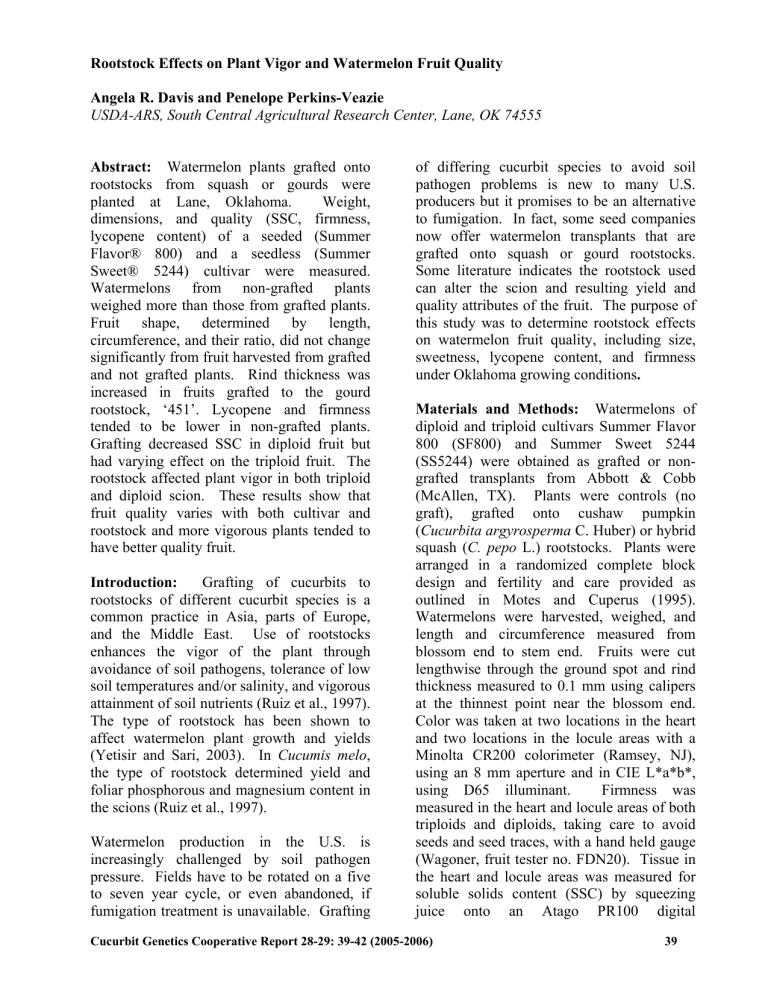Rootstock Effects on Plant Vigor and Watermelon Fruit Quality

Rootstock Effects on Plant Vigor and Watermelon Fruit Quality
Angela R. Davis and Penelope Perkins-Veazie
USDA-ARS, South Central Agricultural Research Center, Lane, OK 74555
Abstract: Watermelon plants grafted onto rootstocks from squash or gourds were planted at Lane, Oklahoma. Weight, dimensions, and quality (SSC, firmness, lycopene content) of a seeded (Summer
Flavor® 800) and a seedless (Summer
Sweet® 5244) cultivar were measured.
Watermelons from non-grafted plants weighed more than those from grafted plants.
Fruit shape, determined by length, circumference, and their ratio, did not change significantly from fruit harvested from grafted and not grafted plants. Rind thickness was increased in fruits grafted to the gourd rootstock, ‘451’. Lycopene and firmness tended to be lower in non-grafted plants.
Grafting decreased SSC in diploid fruit but had varying effect on the triploid fruit. The rootstock affected plant vigor in both triploid of differing cucurbit species to avoid soil pathogen problems is new to many U.S. producers but it promises to be an alternative to fumigation. In fact, some seed companies now offer watermelon transplants that are grafted onto squash or gourd rootstocks.
Some literature indicates the rootstock used can alter the scion and resulting yield and quality attributes of the fruit. The purpose of this study was to determine rootstock effects on watermelon fruit quality, including size, sweetness, lycopene content, and firmness under Oklahoma growing conditions .
Materials and Methods: Watermelons of diploid and triploid cultivars Summer Flavor
800 (SF800) and Summer Sweet 5244
(SS5244) were obtained as grafted or nongrafted transplants from Abbott & Cobb and diploid scion. These results show that fruit quality varies with both cultivar and rootstock and more vigorous plants tended to have better quality fruit.
Introduction: Grafting of cucurbits to rootstocks of different cucurbit species is a common practice in Asia, parts of Europe, and the Middle East. Use of rootstocks enhances the vigor of the plant through avoidance of soil pathogens, tolerance of low soil temperatures and/or salinity, and vigorous attainment of soil nutrients (Ruiz et al., 1997).
The type of rootstock has been shown to affect watermelon plant growth and yields
(Yetisir and Sari, 2003). In Cucumis melo , the type of rootstock determined yield and foliar phosphorous and magnesium content in the scions (Ruiz et al., 1997).
Watermelon production in the U.S. is increasingly challenged by soil pathogen pressure. Fields have to be rotated on a five to seven year cycle, or even abandoned, if fumigation treatment is unavailable. Grafting
(
(McAllen, TX). Plants were controls (no graft), grafted onto cushaw pumpkin
Cucurbita argyrosperma C. Huber) or hybrid squash ( C. pepo L.) rootstocks. Plants were arranged in a randomized complete block design and fertility and care provided as outlined in Motes and Cuperus (1995).
Watermelons were harvested, weighed, and length and circumference measured from blossom end to stem end. Fruits were cut lengthwise through the ground spot and rind thickness measured to 0.1 mm using calipers at the thinnest point near the blossom end.
Color was taken at two locations in the heart and two locations in the locule areas with a
Minolta CR200 colorimeter (Ramsey, NJ), using an 8 mm aperture and in CIE L*a*b*, using D65 illuminant. Firmness was measured in the heart and locule areas of both triploids and diploids, taking care to avoid seeds and seed traces, with a hand held gauge
(Wagoner, fruit tester no. FDN20). Tissue in the heart and locule areas was measured for soluble solids content (SSC) by squeezing juice onto an Atago PR100 digital
Cucurbit Genetics Cooperative Report 28-29: 39-42 (2005-2006) 39
refractometer (Bellevue, WA). About 50 g of tissue from heart and locule was combined and placed in 50 ml disposable centrifuge tubes and frozen at –80
O
C. Tissue was homogenized with a Polytron about 2 days after harvest and lycopene determined using a
Hunter scanning colorimeter calibrated to white and black plates to determine spectrophotometric concentrations of lycopene (Davis et al., 2003).
Vines were removed from the field, measured for length, number of nodes, and number of tendrils branching from the terminal tendril.
A total of 4 to 5 vines per cultivar and graft treatment were used.
Data were subjected to analysis of variance, using a linear model (GLM) and SAS (ver.
8.0). Significant interactions of cultivar and rootstock led to separation of means within cultivars. Means were compared using
Bonferroni, a mean comparison test that compares each mean to the overall mean.
Results and Discussion: Fruit size and shape.
Diploid fruit (SF800) from the nongrafted controls were larger than those from grafted plants, as determined by weight and diameter (Table 1). Grafting did not affect the length, circumference, or diameter of seedless ‘SS5244’ fruit but grafting did decrease the weight of the fruit. The ratio of length to circumference indicates the degree of roundness in a variety, with ‘SS5244’ being more round (lower ratio) than ‘SF800’.
The ratio of length and diameter did not change for either cultivar when grafted, indicating no influence of rootstock on direction of expansion. Rind thickness increased for both seedless and seeded fruits when grafted to gourd rootstock ‘451’ (Table
1).
Fruit quality.
Firmness of the diploid and triploid watermelons was greater from plants grafted to rootstock ‘451’ and ‘1330’ (Table
2). Fruit SSC varied with the cultivar and rootstock but tended to be lower in grafted fruit. Grafting did not greatly affect the amount of red found in the fruit, but it did increase the amount of yellow in 3 of the 5 combinations. This may be an indication of increased ß-carotene and should be tested in future studies. Lycopene content was highest in ‘SF800’ fruit from the squash rootstock grafted plants, while fruit from grafted
‘SS5244’ plants had higher lycopene compared to control fruit. Nisini et al. (2002) found that both scion and rootstock affected fruit quality in muskmelon. In our experiment, genotype (seeded vs. seedless) may react differently to different rootstocks, warranting more study to find superior combinations. In our study, rootstock ‘451’ produced higher quality seedless fruit when comparing lycopene content, firmness, and
SSC than the other two rootstocks and the control. However, seeded fruit from plants grafted to 451 had less SSC than control fruit.
Vine characteristics.
Vine vigor, measured as length of the terminal, number of laterals, and internode length on the terminal vine, was equal or greater from plants grafted to the
‘451’ rootstock compared to control or ‘1330’ rootstock (Table 3).
Our data suggest that gourd rootstock ‘451’ is superior for vigor for both scions and for fruit quality of our seedless variety. However, due to high losses of plants, it was not possible to replicate triploid and diploid cultivars on the
1332 rootstocks. While this report requires a larger follow up study, it provides information on attributes to be considered when comparing grafted and non-grafted watermelons, and gives the first report on cultivars grown for typical U.S. markets for fruit quality and vine vigor between grafted and non-grafted watermelon plants.
Acknowledgement:
The authors would like to thank Julie Collins,
Sheila Magby, and Anthony Dillard for technical help. We would also like to thank
40 Cucurbit Genetics Cooperative Report 28-29: 39-42 (2005-2006)
Diann Baze and Dr. Benny Bruton for some fruit and plant material.
Literature Cited:
1.
Davis, A. R., Fish, W. W., & Perkins-
Veazie, P. 2003, "A rapid hexane-free method for analyzing lycopene content in watermelon", J.Food Sci , vol. 68, pp. 328-
3.
Ruiz, J. M., Belakbir, A., L pez-
Cantarero, I., & Romero, L. 1997, "Leafmacronutrient content and yield in grafted, melon plants. A model to evaluate the influence of rootstock genotype",
Scientia Horticulturae , vol. 71, no. 3-4, pp. 227-234.
4.
Yetisir, H. & Sari, N. 2003, "Effect of different rootstock on plant growth, yield
332.
2.
Motes, J. & Cuperus, G. 1995. Cucurbit production and pest management. OK
Coop.Ext.Serv. and quality of watermelon",
43, no. 10, pp. 1269-1274.
Australian
Journal of Experimental Agriculture , vol.
Table 1. Comparison of fruit size and shape from grafted and non-grafted watermelons.
Rind thickness
Cultivar Rootstock Type number of fruit wt
(kg) length
(cm) circumference
(cm) diameter
(cm)
Length/ diameter
Blossom end
1.5a 11.8ab 9.9b
22.2a 1.2a 12.0ab 9.1ab
451 Gourd 27 6.6a 25.1a
Means separated within cultivar by Bonferoni, P<0.05.
Means followed by the same letter are not significantly different by the Bonferoni method at the P0.05 level of probability.
Cucurbit Genetics Cooperative Report 28-29: 39-42 (2005-2006) 41
Table 2. Comparison of fruit quality from grafted and non-grafted watermelons.
Cultivar
Number of fruit Rootstock Type SSC
Z
Firmness
(Pa)
Y
Lycopene
(ug/g)
12.2a 10.7b 23.4b 26.7b 63.7b
11.7ab 11.8c 24.3b 28.5b 56.0b
1332 11.6ab
27 451 Gourd 12.2a 10.5a 35.4b 26.6b 12.4c 23.9b 29.4b 65.4a
Z
Average of 2 readings, one in the heart and one in the locule.
Y
Average of 2 heart and 2 locule readings per fruit.
Means separated within cultivar by Bonferoni, P<0.05.
Means followed by the same letter are not significantly different by the Bonferoni method at the
P0.05 level of probability.
Table 3. Comparison of vines from grafted and non-grafted watermelons.
Cultivar
SF800
Number of plants Rootstock Type
18 none
Length of main vine
(cm)
Number of nodes
Control 430.8a 57.0a
Internode length (CM)
7.6ab
Number of laterals
16.0b
415.4ab 9.6b
Means separated within cultivar by Bonferoni, P<0.05.
42 Cucurbit Genetics Cooperative Report 28-29: 39-42 (2005-2006)





